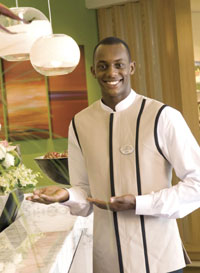Ambassadors bring the brand to life

PICK up an interview with any CEO, and you will most certainly find a reference to employees.
They are often called the ‘finest and most committed’ in their industry and are spoken of with pride as the company’s competitive advantage. Senior leaders know the difference an able and willing employee team can make to the business.
For any business, the road to customer loyalty runs directly through customer service and brand image. Obviously, the value of customer loyalty is not absolutely quantifiable, but to repeat oft-quoted statistics, it costs four to six times as much to win a new customer as it does to retain an old customer.
Most companies, whether they are selling TV dinners, or flying passengers around the world, focus on keeping existing customers happy through the service that those customers receive. The responsibility for providing that service depends upon the employees.
At all positions, employees have two jobs – the first, the work that they were hired to do, the second is representing the organization or conveying the corporate image. The second job is their role as ‘brand ambassadors,’ the main agents in communicating a company's corporate identity to the outside world.
If you take a look at the role ‘brand ambassadors’ play in shaping brand image, great names come to mind – Walt Disney, Federal Express, Nordstorm.
In the restaurant and hotel business, recognition of the interaction of employee behaviour and customer loyalty is so strong, that customers are never referred to as customers, but as guests. The term ‘guests’ encourages a warmer, more hospitable behaviour as opposed to just ‘customers’.
Over the years, my team and I managed to identify a unique customer profile – the holiday gourmet – a guest who typically visited the same restaurant, on every holiday, dining there at least four or five times a week, was familiar with the staff and enjoyed the experience. The guest’s list of priorities included tasty food, prepared under hygienic conditions, warm ambience, and courteous, friendly, respectful service – ‘just like it used to be’.
So I designed the restaurant to provide just that, a restaurant with a traditional feel, ‘just like it used to be’ and all the modern conveniences and amenities, with a large interactive kitchen. I spent long days training my staff to be responsive to guest needs, from reading body language to picking up subtle nuances in guest’s tones.
To build morale, there are many steps that we have taken. We are the first standalone restaurant to insure the lives of our staff. Every year on the anniversary of the restaurant, the staff are given a souvenir. Every two or three months, we order a special meal from a party caterer for all staff. And just to make sure that the quality of staff food does not suffer, the chef and I eat the same food every day.
This has reflected in happy staff who are cheerful and genuinely smile at guests, who are attentive and keen to make sure quality does not slip, and often form life-long relationships with guests.
To an enormous extent, customer satisfaction is a function of employee behavior. In turn, employee behavior is a function of employee morale. If morale suffers, employee behavior suffers. If employee behavior suffers, customer satisfaction suffers. And all of this leads directly to the tarnishing of that other supreme corporate asset: brand image.
Successful service organizations recognize and reward these employees who not only understand, but also play their roles as brand ambassadors. Nordstorm, Four Seasons, Federal Express, Walmart are some companies who have successfully integrated these employees in corporate image programs.
In August 1995, Raoul Pinnell, the marketing director for the NatWest Group, discussed his theory of building a strong brand in Bank Marketing International. “As regards building a brand,” he said, “our strategy is founded on the idea that our brand is our people—that the people who work for the bank create the brand. They are our brand ambassadors.”
While that statement may not be universally true, one thing is certain. For better or for worse, there is an eternal truth that holds for virtually every company: the image of the company that employees, your brand ambassadors, project to your customers is whatever those employees ‘believe’ that image to be.
If a company wants a certain image, then the leadership must ensure that the employees who are to embody that image fully understand it, fully accept it and fully feel that they have a role in making it happen. And employee programmes must support employees in their role as brand ambassadors. There is no other way.
(Leo D’Souza is managing director, La Vida Infinita, and runs After Seven Restaurant in Goa after several years with Taj Hotels & Resorts)
